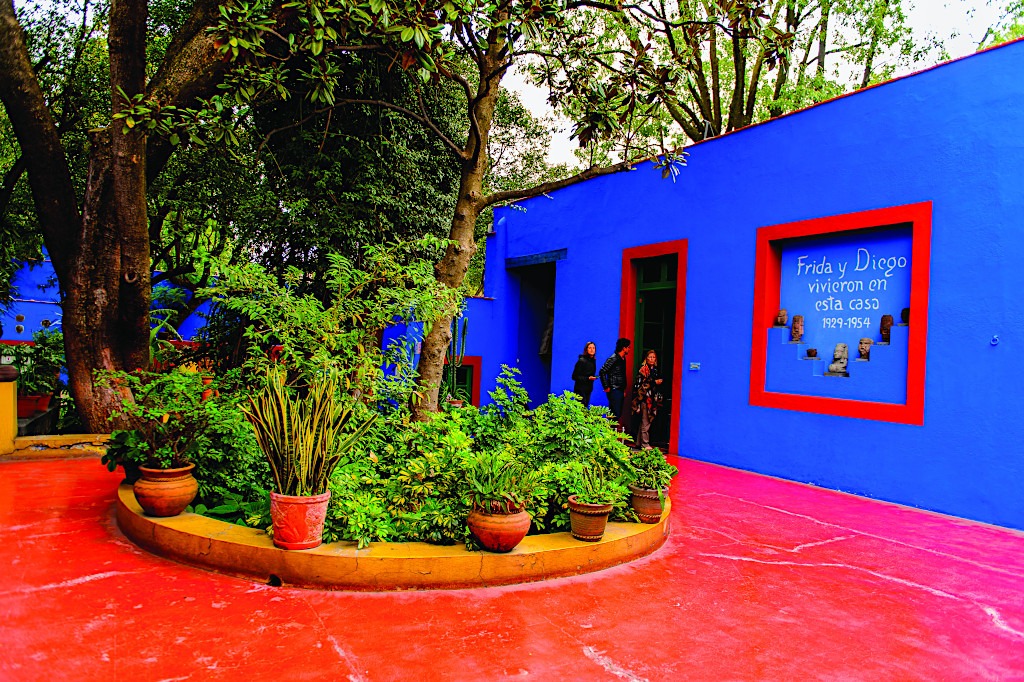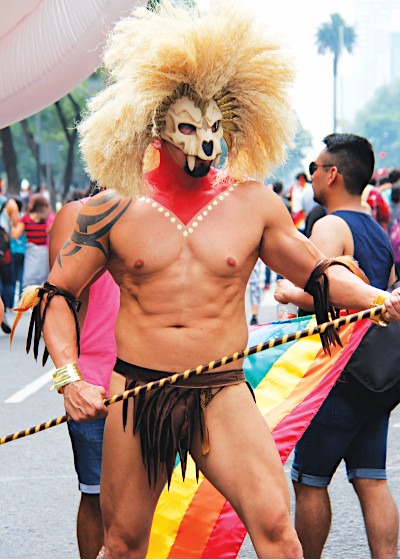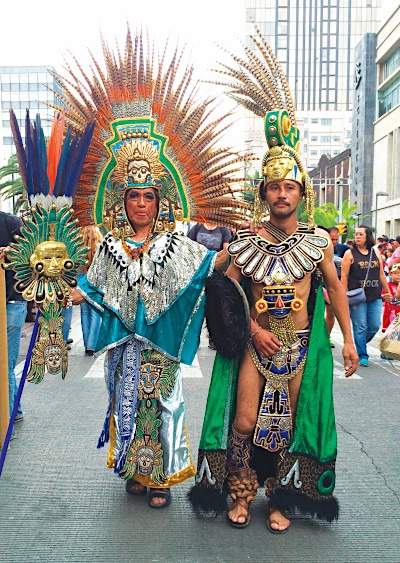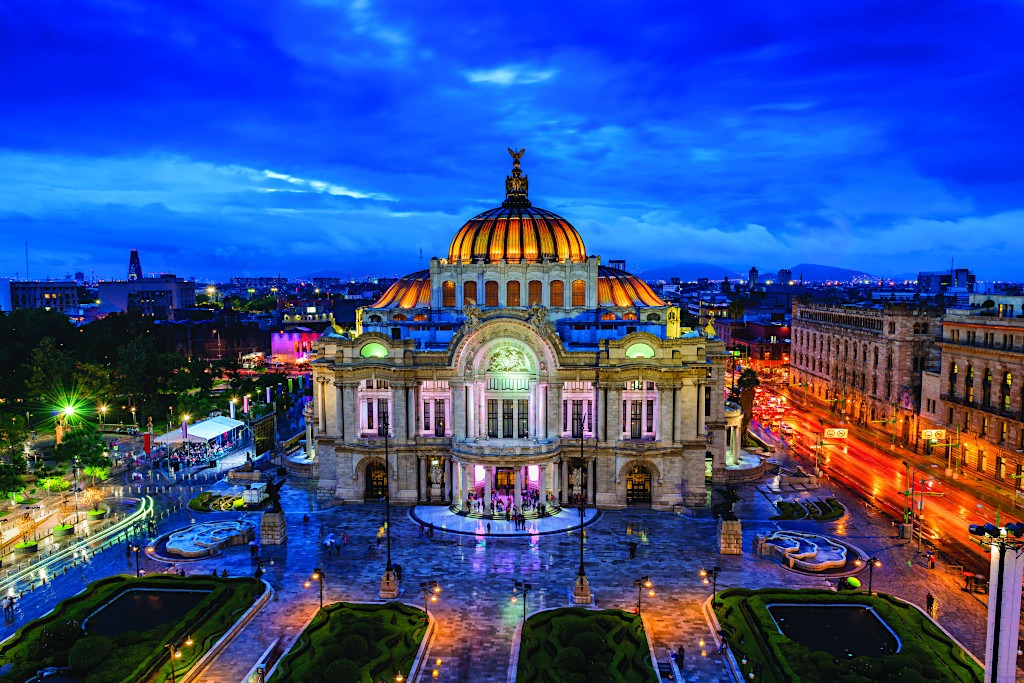Art and design buffs will have lots to love in Mexico City. In the upscale neighborhood of Polanco, the eye-catching Soumaya museum, opened in its current location in 2011, is known as much for its architectural style as its contents, thanks to the building’s interesting curves and 16,000 hexagonal aluminum tiles. Inside, you’ll find sizeable exhibits from a collection of more than 66,000 works spanning some 30 centuries, with notable works by Rodin, Dali, and Tintoretto, to name a few.
Speaking of art, it’s impossible to discuss Mexico City’s creative scene without mentioning two world-famous figures: Frida Kahlo and Diego Rivera. The lives of these fascinating icons are on display at the Museo Frida Kahlo, a museum in the peaceful Coyoacan district that’s also known as the Casa Azul (Blue House). Set in Kahlo’s birthplace and family home, it offers a fascinating glimpse into her life, her possessions, and her art. A quick Uber ride away is the Museo Casa Estudio Diego Rivera y Frida Kahlo (Diego Rivera and Frida Kahlo House Studio Museum), which is set in the twin, attached homes where the couple lived and work. If you’re touring this part of the city and you love 20th-century architecture, consider a stop at the Universidad Nacional Autónoma de Mexico (the National Autonomous University of Mexico, known by its initials, UNAM), wich has a campus that’s a UNESCO World Heritage Site, thanks to its design by some of Mexico’s biggest architects of the last century, as well as its murals by Diego Rivera and David Alfaro Siquieros.

Frida Kahlo Museum
Photo: Anton Ivano
A must-see itinerary for first-time visitors is Xochimilco, a city borough famous for its pre-Hispanic network of canals, which you can glide across aboard colorful trajinera boats. Also worth a visit in this far-southern area of the city is the Museo Dolores Olmedo, a museum housed in a historic hacienda that belonged to famed businesswoman and philanthropist Dolores Olmedo Patiño. Her former home today is best known for exhibiting a large collection of works by two of her close friends, Diego Rivera and Frida Kahlo. Also interesting is the family of resident Xoloitzcuintli, Mexican hairless dogs that were Olmedo’s favorite breed.
There’s lots to see outside the city, too. One of the most memorable day trip destinations is Teotihuacan, the ruins of a city founded sometime around 200 B.C. Located about 25 miles northeast of Mexico City, this breathtaking site is set along the Avenue of the Dead, where you can climb more than 240 steps at the Pyramid of the Moon and 260 steps to the Pyramid of the Sun.
There are countless other attractions and activities around the city, from Broadway-quality theater to over-the-top Lucha Libre wrestling and museums dedicated to everything from shoes to the history of crime. In Mexico City, you’ll never lack things to do.
LGBTQ Life


Mexico City Pride
Photo: LatinFlyer.com
LGBTQ life in Mexico City is vibrant and diverse, and you can find nightlife to suit just about every taste. The thriving epicenter is the Zona Rosa, a centrally located neighborhood that lies off of Paseo de la Reforma. Every weekend (and many weeknights, too), Amberes Street throbs with the beats of multiple bars and dance clubs, most of which are welcoming to all genders and ages. Kinky, on one corner, attracts a young crowd of LGBTQ people and their friends with plenty of pop music for dancing, while Boy Bar is, as the name implies, more focused on the boys, with three floors of different musical styles and a stripper bar section with a back room on the first floor.
Within a few blocks of Amberes you’ll find several other fun nightlife options. Vaqueros is a decidedly unique cowboy bar that packs in lots of men wearing big hats, jeans, and patterned shirts, while next door, El Almacen is a small-but-lively venue with plenty of drag shows and drink specials. Below it lies a dance club called El Nuevo Cabaretito Neón (you can call it just Caberetito Neón), where the drag shows are complemented by a small dance floor, electronic DJ music, and enthusiastic strippers who leave nothing to the imagination.
The bar that’s most oriented toward the bear community (although everyone is welcome) is the appropriately named Nicho Bear & Bar, a Zona Rosa favorite where drinking and socializing are the main focus. For a more exclusively male scene with a randy ambiance, consider a quick Uber ride to Tom’s Leather, a bar that, in spite of the name, has very little to do with leather. What it does have, however, are good DJs, fearlessly naked strippers, and an expansive back room.
The upscale neighborhood called Polanco is home to two equally upscale LGBTQ nightclubs: Envy and Guilt. Live DJs, a welldressed crowd, and the ability to reserve a table make this a top choice for some night owls.


Mexico City Pride
Photos: LatinFlyer.com
In Mexico City’s historic downtown, LGBTQ nightlife has yet another vibe. La Purísima is a Bohemian nightclub with religiousthemed décor that might be deemed offensive by some devout types, and go-go dancers of every stripe and gender identity. Across the street is Marrakech (locals sometimes call it simply Marra), an equally alternative dance club. Both get packed on weekends, so much so, in fact, that you should arrive before 9 P.M. if you want to avoid standing on the street waiting to get in.
For a historic and current overview of LGBTQ life, consider a tour with Go Man Go, a local tour operator that offers not one but three different LGBTQ tours. The first, “Walking Gay History & Monuments,” packs centuries of LGBTQ history, from Aztecs to modern day politics, into a fascinating three-hour tour of the historic city center. Part two continues where the first tour leaves off, highlighting more recent gay life downtown, including gay bar row. Part three heads to the Zona Rosa for a walking tour of modern-day LGBTQ nightlife, with admission and a welcome drink included at six different bars.
The biggest annual must-do event for the LGBTQ community, of course, is the Marcha del Orgullo LGBTTTI, Mexico City’s LGBTQ pride event, which takes place on the last Saturday of June. I’ve been lucky enough to attend on three different years, and it’s one of my favorite pride events on the planet, thanks to its grand size, relaxed ambiance, and festive mood. People really get into pride here, and you’ll see all kinds of creative costumes, as well as a diversity of ages, genders and body types. Unlike the massive New York City pride parade, the procession in Mexico City is more relaxed, with no police barriers, so you can easily divide your time between observing and participating. The march starts at the Angel de la Independencia, the large angel monument on the edge of the Zona Rosa district, and runs down the grand Paseo de la Reforma Boulevard, ending with a festival and concert on the Zocalo downtown.


